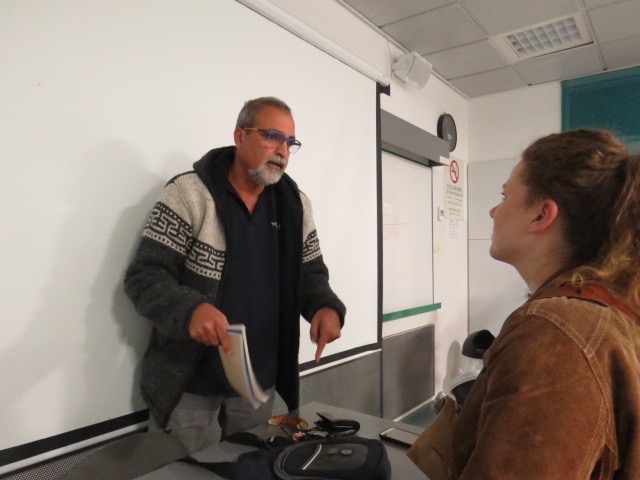Since 2007, Israeli Archaeologist, Yoram Haimi, and Polish Archaeologist, Wojciech Mazurek, have been excavating at the former Reinhard Extermination Camp site, which was created by the SS in Sobibor, occupied Poland. Yoram came to share his research with Cohort V for a Research Forum lecture. All that had been known about Sobibor before the excavation was from about 50 survivors. From their testimonies, historians have made educated guesses on what the camp must have looked like and what happened there. After the uprising in October 1943, the Nazis razed the camp and planted trees to hide their crimes.

Yoram speaking with Annika, University of Haifa Holocaust Studies student
The excavation has revealed some inaccuracies of what has been thought about Sobibor and also proved historian’s theories. The project has made a completely new map of the camp. Originally the major goal of the project was to find the gas chambers. After 7 years they found the foundations of the gas chambers under asphalt which was laid as a foundation to two Polish memorials that were constructed at Sobibor following the war. In the process they found a lot of other details which made the story of Sobibor more complete, such as the escape tunnel that some of the survivors have mentioned.
Sobibor was built in March 1942, as well as other death camps, Treblinka and Bełżec as a part of Operation Reinhard. From April 1942 to October 1943 about 250,000 Jews were murdered at Sobibor. Just like the other death camps there were three main sections of the camp: reception, administration, and extermination. At any one time only about 100 Jews lived at Sobibor. They were forced to aid in the extermination of their own people. Of these workers, around 50 survivor. Their testimonies constructed what was known of Sobibor, now the excavations complete this information.

Yoram speaking with Mason, University of Haifa Archeology Student
Most of the victims of Sobibor were Dutch. Throughout the excavations the team has found valuables such as jewelry. Recently they found a pendent that was identical to one of Ann Frank’s. This pendent belonged to Karoline Cohn. She and Ann Frank were born in the same year, 1929. The pendant was found along the Himmelfarhtstrasse (the street to heaven). The Himmelfarhtstrasse was a path with high camouflaged fences on either side, that lead to the gas chambers. Without the excavations the path would not have been found. When the team found the Himmelfarhtstrasse and then they knew it had to lead to the gas chambers.
When the excavation find items that they can tie to specific people they notify living family members. For example, Yoram told us about a family’s story whose questions they could answer about a small child who was murdered at Sobibor. His sister came to Sobibor and finally said the mourner’s Kodish for her brother, she didn’t know where he was during the war but she was certain that he had been murdered. But she couldn’t be sure until Yoram and his team were able to answer her questions.

Yoram sharing about the different families’ stories he’s been able to provide some answers for.
The excavation includes a team of Polish people from the area, and volunteers. One of our students from Cohort II volunteered and wrote a blog post about it. You can read it here.
For more information, check out the articles below:
http://www.yadvashem.org/research/research-projects/sobibor-excavations
http://news.leiden.edu/news-2015/excavating-the-gas-chambers-at-sobibor.html
Reblogged this on Kattukse Vrienden voor Israël.
LikeLike